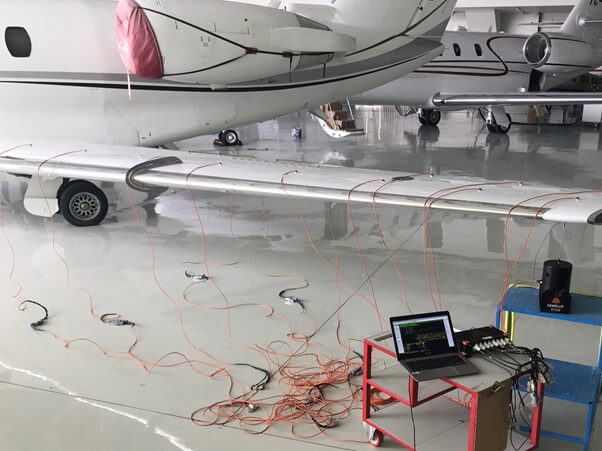This case study on Aircraft Wing Payload Modification was kindly provided by our supplier Dewesoft. For more information on their products or this application, contact us.
RMC Engineering, Turkey
An aircraft operating company in Turkey wanted to modify the wing payloads without drastically affecting the flight envelope. Aircraft are designed for specific flight speeds. However, limited by wing flutter. Thus, anything that affects the natural frequencies of the wing has the potential to reduce the flight speed and narrow the flight envelope. Also increase operational costs and increase the flight durations.
The customer was a local aircraft operator who required a modal test of an aircraft wing. As the operator did not have an engineering department, they requested this test as an engineering service from the Dewesoft partner in Turkey, RMC Engineering. The flight envelope of the current configuration was unknown. Therefore, the current and modified configuration for the wing modal test was performed. Moreover, it was a case of urgency, as the aircraft was only available for a very narrow time frame of two days.
The Aircraft Wing Payload Modification Process:
Firstly, the aircraft tyre pressure was lowered. This provided aircraft boundary conditions similar to the flight. The tests had to be performed quickly. Preliminary modal analyses were performed on-site only for data validation. The whole data acquisition and excitation process were completed with Dewesoft Sirius data acquisition (Sirius HD and Sirius STG with analogue outputs) and Dewesoft modal shaker MS-440 (440 N output force). Because Dewesoft hardware and software is easy to use. The task was completed.
SIRIUS DAQ is a USB and EtherCAT data acquisition system designed to be flexible, modular, expandable, and secure. This simple to use device prevents frequent errors during the measurement process and offers virtually unlimited configuration possibilities. Slices are available from 1 to 16 analogue channel configurations that can be daisy-chained together. An array of different analogue amplifiers is available giving the possibility to connect virtually any sensor.
Modal Shakers
Modal shakers allow for modal testing of larger and more complex structures and the use of various excitation signals. The Dewesoft series of modal shakers are lightweight and powerful modal shakers, electromagnetic actuators, which can go up to 15 kHz and provide force levels up to 440 N with a maximum of 25 mm stroke.
In this case, the wing was fitted with several uni-axial accelerometers. Attached to the tip of the wing was a Modal Shaker (Dynalabs 3002DE). The structure was defined graphically by the Software Geometry Editor. Points and responses were chosen. The modal shaker provided force input and acceleration sensors the measurement of the response, acceleration output. The test points were excited while the software collected the data. The wing was excited with burst random excitations for 50 averages where acceleration signals were collected.
The preliminary mode shapes which were selected from the peaks of the frequency response functions (FRF) were animated in Dewesoft X Modal test plugin. This gave a quick insight into the quality of the measurements.
The Dewesoft Modal test software module is a plugin in Dewesoft data acquisition software. The Modal test module is designed for analysis. For example, of mechanical structures or electrical systems. So they can determine the transfer characteristic (amplitude and phase) over a certain frequency range.
Modal Test Module
The Modal test module generates burst random signals to the shaker. FRF plot peaks were shown by the animated preliminary mode shapes and calculated automatically. Visualising the preliminary mode shapes ensured the confidence in the quality of the measurements. RMC performed the detailed analysis later.
The Modal test module is part of the Dynamic Signal Analysis (DSA) package. Also, along with a range of other modules e.g. Order tracking and Balancing. Plus small and handy instruments, it constitutes a portable solution when coping with failure detection.
The modal tests and analyses concluded that the aircraft operator could use the aircraft with the payload modification. Testing lasted 2 days.
The modal testing of a wing of an aircraft normally has a long preparation and execution time. Such as at least 2 weeks. However, the ease of use of Dewesoft data acquisition system with its modal shakers allowed them to complete the challenge in just two days.
